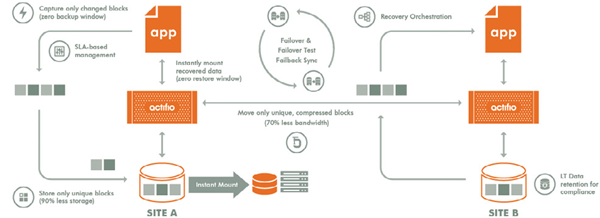 Ashutosh, CEO, Actifio
Ashutosh, CEO, ActifioThe IT landscape has fundamentally shifted, and cloud is at the epicenter of it all. Amazon AWS is approaching $10 bn in annual revenue, Microsoft Azure is approaching $3 bn, while Oracle Cloud is positioning itself as the enterprise cloud for customers. Recently, VMware and AWS partnered to deliver VMware on AWS bare metal to give customers a seamless hybrid cloud experience.
This shift has gradually, but inevitably, brought about a rethinking in how IT organizations use and manage their infrastructure. I regularly speak with CIOs and CTOs who are experiencing this change, and with every week that goes by, more of them are telling me how they are pressing their VP/Director of infrastructure, or Enterprise Architect/DevOps Manager, to design and execute a hybrid cloud model. But what is driving them to make that demand? And how are they starting to map their route to a hybrid model?
“I Want Better Data Insights to Accelerate Sales”
One of the biggest drivers is being able to rapidly provide insights from data to sales and marketing teams to accelerate growth. The CIO of a shoe manufacturer I spoke with needed to identify sales patterns in various geographies, correlate them with many other variables and come up with insights that reveal where and how marketing and sales can grow. But it was taking two weeks to access the data before the analytics team could work their magic. By that time, the data is old news and pretty much useless. For it to be valuable they need it within two days, at most.
"Leveraging hybrid cloud accelerates IT projects, directly impacting revenue and market share growth"
They needed the ability to tap into large compute infrastructure data on demand, in a self-service manner, but without the huge financial outlay of investing in more private infrastructure. A hybrid cloud architecture allows them to dramatically increase the speed and flexibility of their analytics while keeping costs low. It means they can send this data to an Oracle Cloud or AWS only when they need it - perhaps once a month for two days at a time - and use the cloud computing power to get the analytics done, for fractions of what a new data center infrastructure of their own would cost.

“I need to Test Custom Applications more Efficiently”
The CIO of a transportation organization had a different challenge–app development. They wanted to keep their data center resources free of running packaged vendor applications, giving them plenty of capacity to run many of the custom applications they have developed themselves. As part of this process, they had begun migrating applications such as Microsoft Exchange and Sharepoint to Office 365. But in order to reduce time to market of new features and capabilities for those custom apps, they sought to do all test development in the cloud. Adopting a hybrid cloud model allows them to test in the cloud with multiple test environments, and cut application release cycles significantly. The ability to roll out better built applications more quickly will have a direct impact on their top line and market share.
“Security is my Biggest Concern...I needed to take it Step by Step”
Most organizations are scared about cloud security, but the CIO of one very large wealth management firm has crossed the chasm. After putting the right tools and processes in place, his team has been able to extend its security and governance model to AWS. It now has its identity governance, and single sign-on for all applications, completely deployed in AWS.
His roadmap involves shifting most data management use cases to hybrid cloud architecture. Today, it does backup and replication to a second data center where it needs to maintain compute, network, storage, and firewall capabilities. But he doesn’t want any of that infrastructure because it mostly sits idle waiting for a disaster recovery (DR) or DR test at the DR site, wasting precious resource and money. He is asking his team to pick and choose different clouds for different applications or use cases, including all DR, DR testing, and dev testing.
“I just want Flexibility”
For some organizations, hybrid cloud means keeping some production applications on-premises and some in the cloud. Often the applications that are dependent on legacy systems running on non-Intel machines are automatic candidates to stay on premises. If the development teams are planning to create a brand new application using containers and a NO-SQL database like Mongo DB, those new applications are good candidates to be developed and go live in the public cloud which offers a complete platform to be consumed as a service.
These are just a few examples I thought it was worth sharing to underline why there is such a big push to create hybrid cloud architecture and execute on it quickly, and how other CIOs are starting to achieve that ambition. Leveraging hybrid cloud accelerates IT projects, directly impacting revenue and market share growth, while simultaneously giving you the luxury of focusing time and money on applications rather than managing and maintaining the underlying infrastructure.
The shift to the cloud is undoubtedly a major undertaking for any organization. But if approached in small, manageable chunks at first, giving yourself time to acclimatize and adjust, the huge benefits will follow.